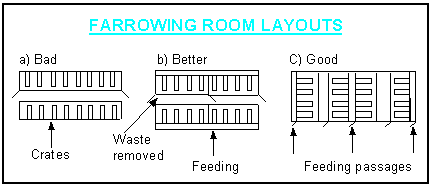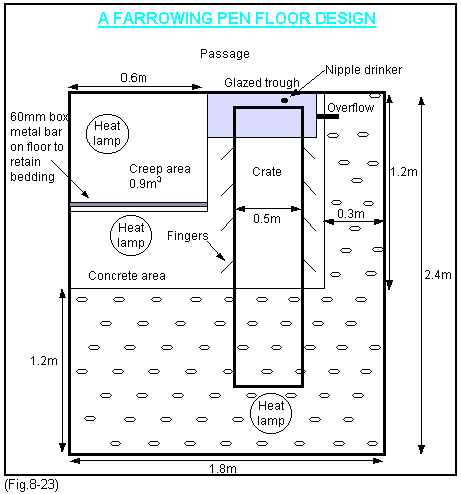



Farrowing house design
The control of piglet diseases is dependent upon the design of the house and the way it is managed. Key features of a good farrowing house:
- The design should enable an all-in all-out management system to be operated with complete cleaning, disinfection and drying of pens between groups. This prevents the build up of infection and reduces the exposure to viruses, bacteria and parasites.
- To achieve an efficient all-in all-out system the farrowing houses should be of a size appropriate to the number of the sows in the herd and the number of farrowings planned for each week. Thus, ideally, in a family farm of 300-500 sows farrowing houses should contain about 10 crates and in smaller herds about 6. In large herds of 1000 or more sows it is useful to have farrowing houses of two or more different sizes, say, 10 to 12 crates and 20 to 24 crates. If rooms are bigger than this the farrowing spread becomes too large to operate an efficient all-in all-out system.
- The floor and work surfaces should be made of non-porous easily cleaned materials that dry quickly.
- The floors should be well constructed and drained so that no pools of liquid occur and they should be free from cracks and fissures that harbour infections.
- The rooms should be adequately insulated and the ventilation system should maintain even temperatures with no draughts around the sows or piglets. In temperate and colder climates the system should be mechanically operated.
- There should be passages in front of the farrowing pens as well as behind them for easy access to the piglets, without climbing from one pen to another. This is particularly important when outbreaks of piglet diarrhoea occur.
Examples of farrowing house layouts are given in Fig.8-22.

(Fig.8-22)
Farrowing crate and pen design are important in the management of the sow and litter. Pig producers are nothing if not resourceful and ingenious and it is not surprising that over the 25 to 30 years of the development of the modern industry a variety of pen and crate designs have been developed, some good, some not so good, none perfect. Numerous pens have been designed that avoid total confinement of the sow in a crate or which confine the sow for the first few days of lactation and then allow her free movement (e.g. multi suckling systems) but they have all been found wanting and some have been disastrous. There is, as yet, no system more productive and welfare friendly to the piglets as well as the sow and safe for the attendant, than full confinement in a farrowing crate for most or preferably all of lactation, provided weaning is at less than 41/2 weeks.
An example of a satisfactory farrowing pen layout is shown in Fig.8-23.

The pen area is a minimum of 1.8m wide by 2.4m with the crate offset to one side with a side creep to the larger side close to the front passage. Provided the management is good there seems to be little difference in piglet mortality whether the creep is in front of the sow (as in the Camborough crate), to one side of the head of the sow (as in Fig.8-23) or further back, level with the udder. The position of the creep in Fig.8-23 gives the piglet contact to the sows head, fostering a maternal bond. It encourages the piglets to remain at the head of the sow rather than at the udder where they may be laid on. In hot climates a heated front creep may prevent the sow cooling herself and drip cooling procedures become necessary.
Crate designs vary widely and serve several purposes.
- Safety for the stockperson.
- Ease of management for such procedures as clipping teeth and tailing, examining the piglets and the sows udder.
- Treating the piglets or the sow, feeding, changing creep feed and general hygiene.
- Provision of a simple safe creep close to the sow for the piglets.
- Reducing piglet mortality from crushing and disease.
- Economy of space in the farrowing room.
One guide to the efficiency of the design is the level of mortality achieved but other factors should also be assessed, such as the comfort and contentment of the sow, whether the crates are big enough for the biggest sows and the availability of both rows of teats to the piglets. To facilitate this ( and to reduce crushing against the bottom bar) "fingers" are incorporated as in Fig.8-23 instead of a low bottom bar. Various gadgets have been developed to reduce crushing when the sow lies down:
- Adjustable bottom rails for different size sows.
- A hinged bottom bar that drops inwards when the sow stands up making it difficult for her just to drop down when lying again.
- Bottom bars that operate on an hydraulic ram (the proctor crate) so that the sides swing in when the sow stands and will only swing out slowly again when the sow starts to lie down. Such crates are expensive and elaborate but they do help to reduce mortality.
- Crates with a fan that automatically turns on when the sow stands and blows cool air around her feet (blowaways) encouraging the piglets to return to the creep.
The floors of farrowing crates are important to piglet survival and health. If solid they should be insulated, smooth enough not to cause abrasions on the piglets legs but not too smooth and slippery to make it difficult for the newborn piglet to get to the udder and creep area.
Floors may be fully perforated , partly perforated as in Fig.8-23 or only perforated at the back end of the sow. They may be raised to various heights above the passage level to help in manipulation by the stockperson, to deter the stockperson from climbing, and to raise the piglet away from draughts at floor level.
Whilst crate design is important in assisting the sow to lie down gently, nevertheless its impact on pigs laid on is low if the management and the design of the house encourages the piglet not to lie in the danger dropping zone. The day by day management of the pen, the bedding and good drainage of the floor are vital components for success.
Good management in the farrowing house is the key to the successful rearing of healthy pigs and low pre-weaning mortality.





